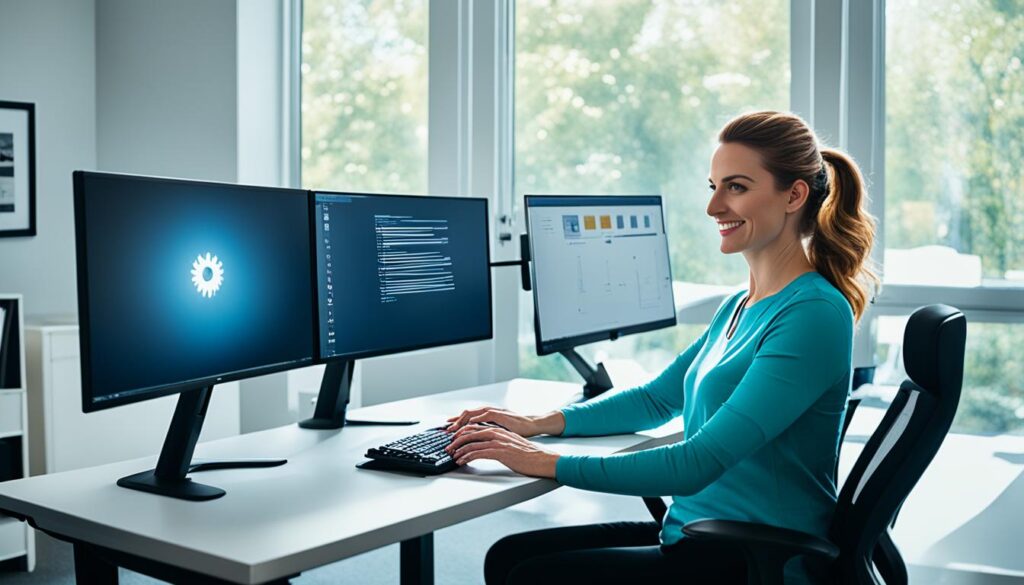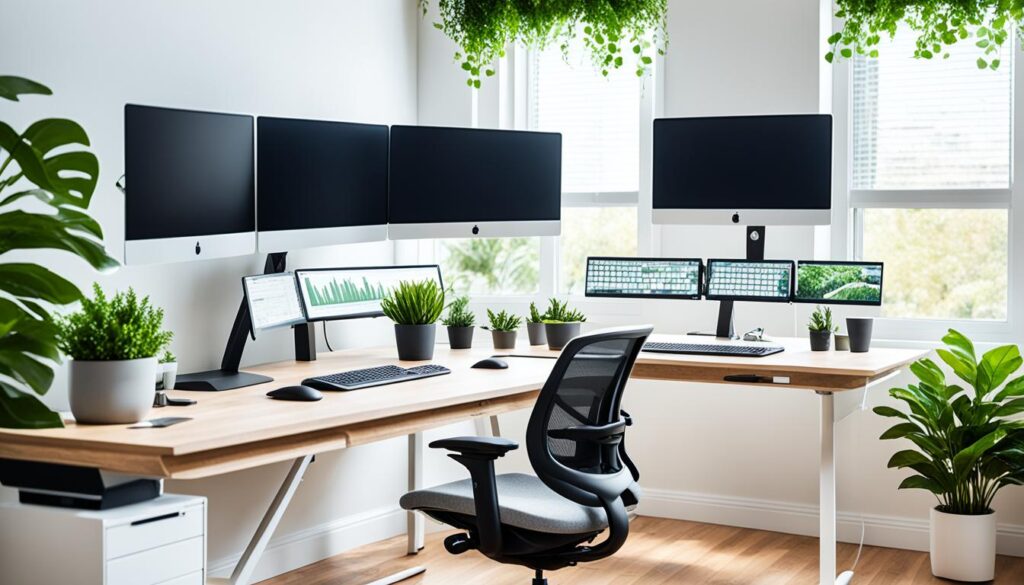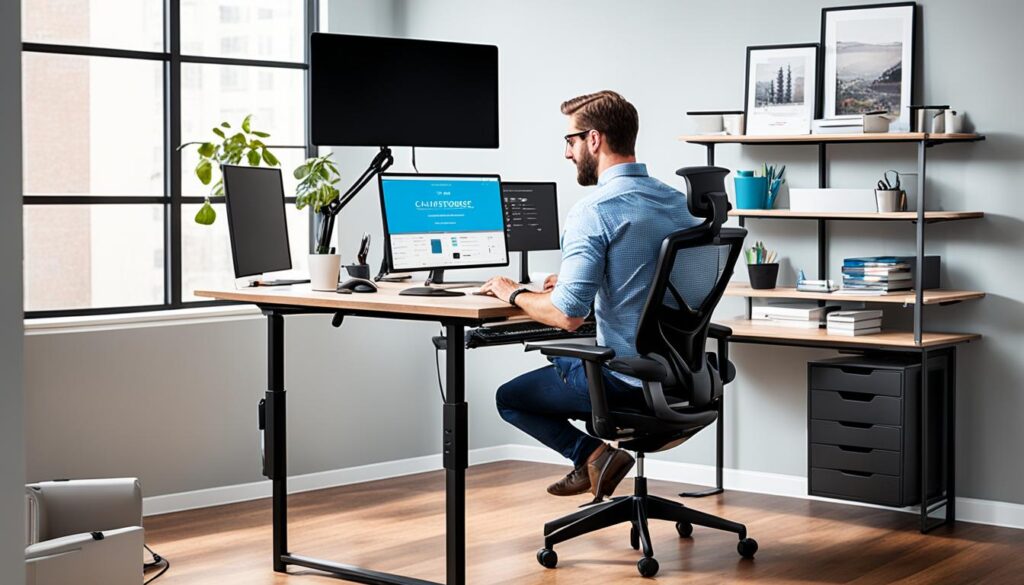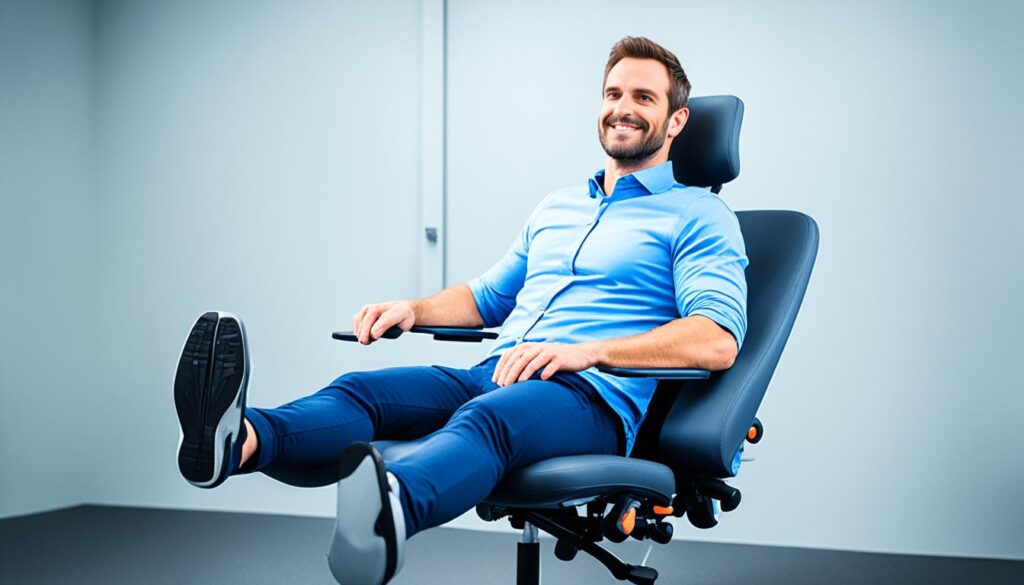Creating an ergonomic workspace does not have to be costly. It’s a common misunderstanding that you need fancy furniture. With just simple tweaks using what’s around your house, you can have a comfy space that keeps you safe. Learn how to care for your neck, back, and eyes. Discover ways to make a workspace that boosts both your work and health.

Key Takeaways:
- Create an ergonomic workspace without expensive furniture
- Utilize simple adjustments using items you already have
- Protect your neck and back with proper positioning
- Prevent digital strain on your eyes with the 20-20-20 rule
- Dedicate a specific workspace, even at home, for optimal ergonomics
The Role of Equipment in Ergonomics
The right equipment and setup are key for a comfy and safe workspace. Chairs, desks, and screens help optimize your station. This boosts productivity and well-being.
Ergonomic Chairs for Optimal Support and Posture
A supportive chair is vital for a good workstation setup. Ergonomic chairs give proper back support and adjustable features. They reduce pain in the shoulders, arms, and wrists. These chairs help you maintain a healthy posture, letting you work longer without discomfort.
Desks: Comfortable Height and Adequate Space
The right desk is crucial for a good ergonomic station. It should let you keep a good posture while you work. A desk needs plenty of space for your tools, keeping your area neat.
Screens: Positioning for Visual Comfort
Correct screen placement helps avoid eye strain and maintain good posture. Put screens at arm’s length and tilt them between 10 and 20 degrees. This keeps your head and neck neutral, reducing injury risks from long screen time.
Ergonomic Keyboards and Mice for Enhanced Comfort
Ergonomic keyboards and mice ease discomfort during long computer use. They are made to lessen strain on wrists, hands, and fingers. Ergonomic keyboards support natural wrist positions, while ergonomic mice are easier to hold. They help prevent strain injuries.
Choosing quality ergonomic equipment and setting it up right is crucial. It makes your workspace safe and boosts your health, comfort, and productivity. The right gear also helps prevent work-related injuries.
Lifestyle Changes to Support Ergonomic Health
Making changes to your routine and workspace can boost your ergonomic health. Simple life adjustments can help avoid work injuries and better your posture. Here are key ways to make your work experience better:
- 1. Keep your workspace comfy and nice to look at with good lighting. Good lighting helps avoid eye strain and keeps you well. Use desk lamps that you can adjust or natural light to brighten your space.
- 2. Make sure to take breaks to move and do some physical activity. Sitting too long or staying in one pose can tire your muscles and cause discomfort. Try stretching, short walks, or stand-up meetings to keep moving.
- 3. Think about using screen covers and glasses that block blue light. Looking at screens a lot can strain your eyes and mess with your sleep. Screen covers and blue light glasses can protect your eyes and lessen digital strain.
Creating a good work experience means adjusting your environment, moving around, and using the right tools. Even small changes can greatly help prevent work injuries and better your posture.
Now, we’ll show a picture to help understand the benefits of these lifestyle changes:

| Lifestyle Changes | Benefits |
|---|---|
| Maintaining a visually pleasing workspace | Less eye strain, better focus, and more productivity |
| Taking breaks and being active | Better blood flow, stronger muscles, and lower risk of muscle problems |
| Using screen covers and blue light glasses | Saves eyes from screen strain, avoids sleep issues, and makes seeing more comfortable |
Ergonomic Workstation Assessment
To create a healthy and safe workspace, it’s important to do an ergonomic workstation assessment. This process checks different factors to build a workplace that stops injuries and supports well-being.
Evaluation Criteria
- Seating Posture: Look at the chair’s ergonomic features like backrest, adjustability, and cushioning. Make sure the backrest supports the spine’s curve to promote good sitting.
- Desk and Chair Height: Find the right desk height and adjust the chair to match. The forearms should rest easily on the desk, making a 90-degree angle with the upper arms.
- Lumbar Support: Check the chair’s lumbar support to ensure it backs the lower back and keeps the spine’s curve. A good ergonomic chair with adjustable lumbar support can prevent back pain.
- Monitor Positioning: Place the monitor to avoid neck and eye strain. The monitor top should be at or just below eye level, an arm’s length away, and tilted back 10-20 degrees.
- Keyboard and Mouse Placement: Position the keyboard and mouse to reduce wrist and arm strain. They should allow the forearms to rest easily on the desk, with wrists in a neutral posture.
- Lighting Conditions: Make sure the workspace lighting is enough for easy reading and screen viewing without glare or shadows. Consider adding adjustable task lighting to help out.
Assessing these areas lets employers and workers find what needs improvement. Then, they can make ergonomic changes that fit their needs. The aim is to make a workplace that is good for physical health and stops injuries.
For more help on ergonomic design at work, the Occupational Safety and Health Administration (OSHA) has a detailed checklist.

| Evaluation Criteria | Key Considerations |
|---|---|
| Seating Posture | Chair backrest support, adjustability, and cushioning |
| Desk and Chair Height | Forearm and upper arm angles, alignment with desk height |
| Lumbar Support | Chair’s ability to provide lower back support and maintain spine’s natural curve |
| Monitor Positioning | Monitor height, distance, tilt, and alignment with eye level |
| Keyboard and Mouse Placement | Positioning to minimize strain on wrists and arms |
| Lighting Conditions | Adequate lighting for comfortable reading and screen viewing |
This full assessment makes sure that ergonomic office design is a priority. This creates a safer, more comfortable workspace that also prevents injuries.
Setting Up an Ergonomic Workstation
Creating an ergonomic workstation involves careful selection of furniture and equipment. It also involves implementing proper body mechanics. By doing this, you can boost comfort and lower the chance of musculoskeletal issues. Here are some tips for setting up an ergonomic station:
1. Chair and Desk Heights
The right ergonomic chair can greatly enhance your sitting experience. Pick a chair that lets you adjust its height for correct posture. Ensure your feet are flat on the ground and your knees at a 90-degree angle. Also, make sure your desk height matches your chair to avoid strain.
2. Keyboard and Mouse Positioning
Positioning the keyboard and mouse correctly is key to avoiding wrist and hand strain. They should be right in front of you, with elbows at a right angle. The keyboard should be at a height that keeps your wrists straight. The mouse should be within easy reach. Think about getting an ergonomic keyboard and mouse for the best hand and wrist position.
3. Avoid Extended Laptop Use
Laptops are convenient but can lead to poor ergonomics. Their small keyboards and trackpads can strain your wrists and hands. If you use a laptop a lot, get an external keyboard and mouse. This helps you set them up in a more ergonomic way, reducing discomfort and repetitive strain injuries.
4. Monitor Positioning
Your monitor should be at eye level to keep a proper posture and avoid neck strain. Place it an arm’s length away, slightly angled backwards. The top of the screen should be at eye level. Use a monitor riser or adjustable stand if needed. Adjust your monitor regularly to ensure it’s in the right position for your sight, comfort, and well-being.

By following these guidelines, you can make an ergonomic workstation that boosts your well-being and productivity. The aim is to improve comfort and lower the chances of discomfort or injuries from long sitting and poor posture.
| Ergonomic Workstation Setup | Ergonomic Chair Benefits | Ergonomic Keyboard and Mouse Usage |
|---|---|---|
| Promotes proper posture | Provides support and stability | Reduces strain on wrists and hands |
| Enhances comfort and productivity | Adjustable features for customization | Optimal positioning for ergonomic alignment |
| Reduces the risk of musculoskeletal problems | Prevents back and neck pain | Improved hand and wrist positioning |
The Importance of Ergonomic Chairs
Ergonomic chairs are more than a fancy item; they’re key to a comfy, safe work area. They help in maintaining a good posture. They also cut down the chance of musculoskeletal problems.
One great thing about these chairs is their adjustable seat height. This means you can make the chair just right for your body. You want your feet flat and knees at a 90-degree angle to boost posture and ease back strain.
The size of an ergonomic chair matters too. You need the right support to stay comfy and healthy while sitting. A chair that’s too small or big can lead to discomfort or bad posture.
Don’t forget about armrests. They support your arms and wrists when positioned right. This keeps your shoulders and wrists pain-free.
When picking an ergonomic chair, think about what you like and your body needs. Since everyone is different, try various chairs to find the best one for you.

Benefits of Ergonomic Chairs:
- Improved posture and spinal alignment
- Reduced risk of musculoskeletal disorders
- Enhanced comfort and productivity
- Prevention of shoulder, arm, and wrist pain
- Customizable features for individual needs
“Investing in an ergonomic chair is an investment in your health and well-being. By prioritizing comfort and proper posture, you can create a workspace that promotes productivity and reduces the risk of work-related injuries.”
Remember, an ergonomic chair is just one part of an ergonomic workspace. Also, look at desk height, where your monitor is, and how you set up your keyboard and mouse for the best ergonomics.
Maintaining Good Posture and Body Mechanics
Keeping a good posture and knowing how your body works is key to staying safe at work. By making sure you’re sitting or standing right, you can feel better and avoid getting hurt on the job. Here are some easy tips to help you keep your posture in check while you work:
Sit Correctly
Make sure to sit with your back against the chair and relax your shoulders. Don’t slouch or lean too much. Your feet should be flat on the ground, knees making a right angle. This evens out your weight and keeps your back and neck happy.
Stand with Stability
When you’re on your feet, spread your weight evenly. Use your core muscles to stay balanced and straight. Be careful not to lock your knees or tilt to the side. Doing so can mess up your posture and cause discomfort.
Adjust Your Workstation Height
Your workspace should let you keep your arms cozy. Elbows at a right angle and forearms should be parallel to the ground. Adjust your chair and desk to make this happen. This is the best way to sit.
Avoid Non-Ergonomic Workspaces
Bad posture and doing the same thing over and over can hurt your neck and shoulders. Make sure your workspace is set up right. This helps keep your body aligned and cuts down on muscle problems. Think about getting ergonomic chairs and tools that help you stay in a good posture.
“Maintaining good posture and body mechanics is essential for protecting your health and well-being while working.”
Remember, using ergonomic tips does more than just fix your posture. It also makes you more productive and less likely to get injured at work. By following these tips, you can make your workplace safer and more comfy.

| Ergonomic Tips | Benefits |
|---|---|
| Practice good posture | Reduces strain on the back and neck |
| Adjust workstation height | Maintains comfortable arm positioning |
| Use ergonomic furniture | Supports proper body alignment |
| Create an ergonomic workspace | Prevents musculoskeletal injuries |
Preventing Neck and Shoulder Injuries
Slouching or hunching over a desk can cause neck and shoulder pain. To avoid this, it’s important to follow ergonomic advice and do exercises. This helps prevent pain from workplace injuries.
Regular stretching can ease tension and stop injuries. Simple movements like head tilts or shoulder rolls help. They ease desk work strain, boost flexibility, and better blood flow.
Choosing keyboards and mice with cushioning helps avoid wrist pain. It also supports your neck and shoulders. Ergonomic keyboards and mice ensure your hands and arms are in a natural, stress-free position.
Right lumbar support in chairs is critical for good posture. This is vital for your neck and shoulders. Look for chairs with adjustable support to keep the spine aligned. This lowers pain risks. Also, taking breaks from sitting too long is key. It eases lower back and neck pressure.
Simple Ergonomic Tips for Neck and Shoulder Health
- Ensure desk height aligns with chair armrests for a comfy position.
- Adjust the computer monitor to eye level to prevent neck strain.
- Take short breaks to stretch and rest your neck and shoulders.
- Use a supportive chair with proper armrests to lessen neck and shoulder tension.
- Consider an ergonomic standing desk or sit-stand workstation to avoid strain.
By using these ergonomic tips daily, you can lower neck and shoulder injury risks at work. This leads to more comfort and productivity.

Mitigating Wrist and Hand Strain
Paying attention to how you use your keyboard and mouse is key for a comfortable workspace. Using keyboards that are too high can make your wrists hurt. **Continuous typing or using a mouse without breaks** can lead to carpal tunnel syndrome and tendonitis. To avoid these problems, it’s crucial to keep your wrists positioned correctly and take breaks often.
To ease wrist and hand strain, make sure your wrists are at **natural angles** when you type or click. Keep your wrists straight, avoiding too much bending. This helps lessen the strain on your tendons and muscles. Also, take **frequent short breaks** to stretch and rest your hands and wrists. This prevents injuries from overuse.
Adding stretching exercises to your daily routine can also reduce wrist and hand strain. Stretching your arm and gently pulling back your fingers for a few seconds is a good start. These actions increase flexibility and lessen muscle tension. Make sure to do these stretches regularly for the best results.
By using your keyboard and mouse the right way and taking these steps, you can avoid wrist and hand injuries. Keeping your wrists and hands safe is important for staying comfortable and productive at work.

Image: Illustration of a person using an ergonomic keyboard and mouse.
Protecting the Lower Back
Sitting too long without proper support strains the lower back. Your lower back’s health and comfort should be a priority when working. An ergonomic chair can greatly improve your posture and benefit you at work.
The Benefits of Ergonomic Chairs
Ergonomic chairs support your lower back and help maintain good sitting posture. They have adjustable features for a personalized fit to your body’s needs. Here are the perks of ergonomic chairs:
- Reducing pressure on the lower back: Ergonomic chairs provide proper lumbar support. This keeps the spine’s natural curve and lessens lower back strain.
- Improving posture: Features like seat height, armrests, and backrest angles in ergonomic chairs boost good posture. They prevent slouching or leaning too far forward.
- Enhancing comfort: Designed for optimal comfort, ergonomic chairs have cushioning and padding. This makes sitting for long hours more comfortable.

In addition to an ergonomic chair, take regular breaks and stretch. Stand up, stretch, and lengthen your spine during breaks to reduce tension. Make your well-being a priority by creating an ergonomic workspace for your lower back and overall health.
Conclusion
Make your workspace ergonomic to stop injuries and boost comfort. This improves your work output. Focus on the right tools, lifestyle changes, and keeping the right posture.
Checking and adjusting your space regularly is vital. It keeps you healthy and comfy at work for a long time.
Using ergonomic tips is good for you. It helps you work better and with ease. This lowers the chance of getting hurt at work. Set up your space at home or in the office with your health in mind.
Don’t ignore your health, pick ergonomic options that suit you. Look after your body, and it will support you in your career. Start using these ergonomic tips now and see how they change your day.